
» café reason
» butoh
» diary
» new work
» past work
THEATRE WORK
»» limina
»» dolls' house
»» the heart's desire
»» matrix
»» orpheus
»» precarious footing
»» the if path
»» guess-station
»» la table
»» erosion
»» echo
»» bona dea
SITE SPECIFIC WORK
» classes
» contacts
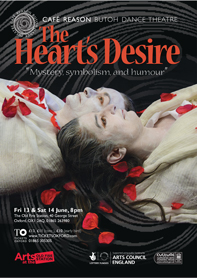
Flyer for The Heart's Desire
(Photo: Paul Freestone)
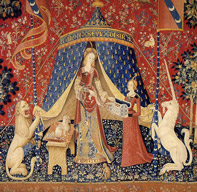
À Mon Seul Désir
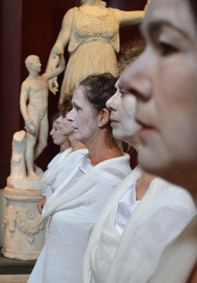
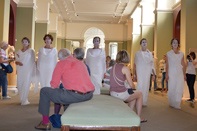
Work-in-progress performance at the Ashmolean museum
(Photos: Peter Green)
Work-in-progress performance video (4 mins) at the Ashmolean Museum
(Video: Peter Green)
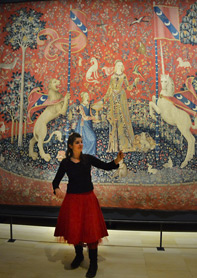
Bitzia and 'Taste'
at the Cluny Museum
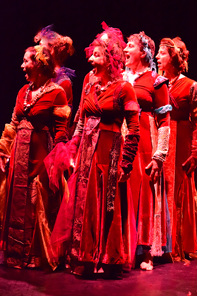
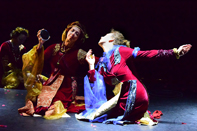
Performance of 'The Heart's Desire'
at the Old Fire Station; 'Sight'.
Photos by Paul Freestone
Old Fire Station performance highlights (8 mins)
Camera: Erika Montenegro, Pawel Palczynski, Peter Jones
Editing: Erika Montenegro
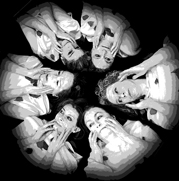
'Carousel' image from Programme Notes
Photo by Paul Freestone
Graphic design by Ayala Kingsley
THE HEART'S DESIRE
“The reconciliation of virtue and vice, the self and the shadow, and the anima with the animus serves as the central quest of human beings as they search for wholeness and meaning in their lives.”
(Carl Jung)
This innovative, cross-genre work, premiered in June 2014 at the Old Fire Station theatre, was a collaboration with - and the inspiration of - voice artist Anne L Ryan. The performance combined butoh with live voices and percussion (and an original, recorded soundscape) in an attempt to dissolve the boundary between these art forms and to bring a new dimension to the silent worlds of both butoh and the extraordinary medieval tapestries that inspired it.
The Heart's Desire took as its source the six 15th-century tapestries known as The Lady and the Unicorn, displayed in the Cluny Museum, Paris. Each of the first five tapestries is thought to depict one of the senses - Touch, Taste, Smell, Hearing, and Sight. The sixth tapestry, which bears the enigmatic inscription 'À Mon Seul Désir' (To My One Desire), is much more mysterious, and interpreted variously as representing the assertion of Free Will, the renunciation of worldly passions, or an internal sixth sense - 'Understanding', located in the heart.
"When I stood in front of the huge tapestries of 'The Lady and the Unicorn' I was awestruck. They were powerful in size and meaning. I looked at the woman and wondered what her quandary was. I wanted to explore it using all the senses." (Anne L Ryan, Voice Artist)
The iconography of the tapestries involves a rich symbolic code, typical of mediaeval culture; the objects, animals and plants are all imbued with spiritual significance, such as the eternal human struggle between moral ideals (the unicorn) and worldly inclinations (the lion). The mirror, held up by the woman in the 'Sight' tapestry, is both a symbol of the external sense of sight, and also of insight. The object of desire may be the heart of another human being, but equally may be the 'true self' or even the transcendent soul.
We explored these themes through both voice and movement, beginning with an investigation into the five senses and how they might be approached in performance. Our first stage of development culminated in a work-in-progress event at the Ashmolean Museum, Oxford in August 2013 in the Randolph Sculpture Gallery (see Ashmolean video). The five senses were given expression in a site-specific performance relating to the architecture of the gallery and the classical statues on display.
"As dancers, it has been a huge challenge to use our voices. For Anne, this was a central feature of her proposed project. There is always the risk that by using both voice and movement we weaken both, but we hope we have managed to find places where the combination creates a new and stronger experience for performers and audience alike." (Ana Barbour, Café Reason)
In our next phase of research, we examined the mood and detail of each tapestry, in order to generate choreographic material, some of which was presented in November 2013 at Diamond Night #12. A huge inspiration was our trip to the Cluny Museum in Paris in January 2014 to study the tapestries in-situ.
The visit to Paris inspired the eventual creative direction of the piece: each sense would be presented as a solo featuring its distinctive Lady, each with a unique ‘soundworld’, and framed in contrasting ways by a ‘chorus’, while a Prologue and Epilogue would present the Lady ‘Free Will’ and her dilemma. Anne recorded our individual voices in movement, so that a soundscape for each dancer could be created.
Further work-in-progress was presented in April 2014 at the Old Fire Station and at Diamond Night #13. As we moved through the final development phase, we were joined by Jill Elliott (musician), Dominic Hargreaves (sound designer), Josh Tomalin (lighting designer), and Joanna Matthews (production/marketing manager) who all contributed enormous creative skill and enthusiasm. The full performance was staged at the OFS in June (see video and programme notes). There was no press review, but dance artist Miranda Tufnell wrote this preview:
‘The combination of Anne L Ryan¹s sound score with the dreamlike succession of images, make for a performance that is rich and full of surprises as each scene unravels and transforms. …here Butoh meets Courtly Love and the result is strange, hilarious, tender, and shocking. Each of the six dancers brings a uniquely personal quality to the whole – as if the formal scenario of the tapestries becomes a waking dream – at once both melodic and dissonant. It is this quality of dissonance and contradiction that gives the piece its unsettling strength. It is a journey from stately to burlesque, from iconographic to personal – and within this an echoing of medieval morality plays. This is a richly imaginative and engaging performance.’
The staging of this performance is supported using public funding by the National Lottery through Arts Council England, and with Culture funding from Oxford City Council.


The sound design for The Heart's Desire uses many sounds from Freesound:
boiling water.wav by mzoern1 -- License: Sampling+
pots and pans.wav by tonywhitmore -- License: Attribution
200903.pouring.01.wav by dobroide -- License: Attribution
French Champagne.wav by Puniho -- License: Attribution
water trickle 1.flac by Corsica_S -- License: Attribution
baby_voice16.wav by reinsamba -- License: Attribution
bigben_5_uhr_5_a_clock-my_grandmas_clock.mp3 -- License: Attribution Noncommercial
Bell2.wav by juskiddink -- License: Attribution
MedievalCombatLoop.mp3 -- License: Attribution
Glass5.wav by juskiddink -- License: Attribution
Wheel Lathe.WAV by Benboncan -- License: Attribution
pub-reverb.wav by Erdie -- License: Attribution